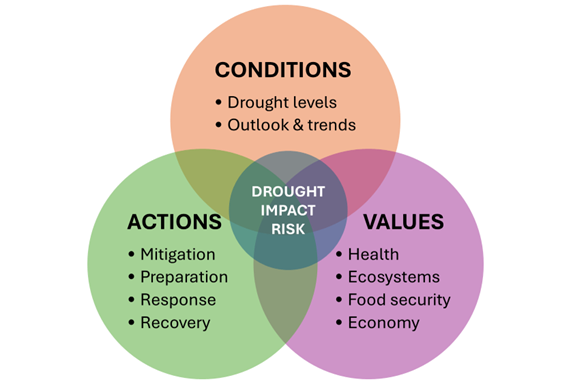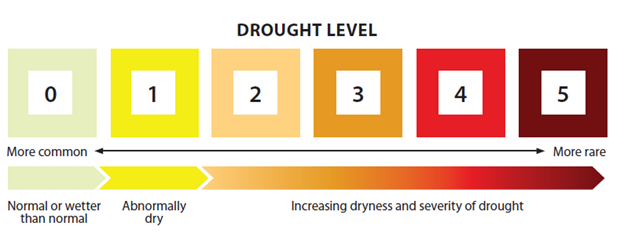Drought information
Drought is a naturally reoccurring period of abnormally dry conditions that may result in water scarcity or other adverse impacts on people, aquatic ecosystems, wildlife or vegetation.
Water scarcity is when there is not enough water to meet the needs of people and ecosystems.
On this page
- Understanding drought and water scarcity
- Drought monitoring
- Drought levels
- Effects of drought
- Water management during drought
Understanding drought and water scarcity
Drought may be caused by combinations of insufficient snow accumulation, earlier or rapid snow melt, prolonged hot and dry weather or a delay in rainfall.
Drought can be characterized according to the state of dryness (meteorological or hydrological drought), or the effects of that dryness (ecological, agricultural or socio-economic drought). Each definition implies different impacts.
While there are many types of drought, they all occur as a temporary deviation from normal or expected conditions. Individual drought events vary in their magnitude and duration. While most droughts develop slowly and have no obvious start and end dates, rapid-onset flash droughts can also occur.
Water scarcity occurs when there is not enough water to meet the needs of people or ecosystems. Water scarcity is a function of both climate and human activity. It can occur in the absence of drought or be introduced or made worse by drought.
Drought monitoring
Drought conditions and impacts are monitored to better understand the risks of being impacted by drought. Understanding this risk of impact can help inform the type and extent of actions needed to reduce risk and be ready to respond.
There are three main factors that contribute to the risk of experiencing drought impacts:
- Physical conditions: Meteorological and hydrological conditions are monitored to understand the severity of drought and its expected frequency of occurrence
- The values held: The risk of experiencing drought impacts depends on what assets are valued, such as human health, the natural environment or food security, which may be exposed or vulnerable to drought in different ways
- The actions taken: Effective drought management that minimizes the risk of impacts can involve mitigation, preparedness, response and recovery actions that all increase resilience to drought
The diagram below illustrates the various factors that contribute to drought impact risk:

Drought levels
Provincial drought levels represent the severity of drought conditions relative to the historical record.
The B.C. government uses a six-level classification system to assess drought conditions (Level 0 to Level 5).
Provincial drought levels are set following the guidance in the British Columbia Drought and Water Scarcity Response Plan (PDF, 1.2MB)
To improve clarity and consistency in interpreting the meaning of drought levels, the B.C. government has updated the definition of drought levels for 2025, while maintaining the same six-level rating scale. This update means that drought levels now serve as an objective measure of the severity and prevalence of drought hazard across the province, aimed at improving the evaluation of drought impacts and risk.
Drought levels:
- Represent how dry it is, relative to the historical record
- Tell us how often a given level of dryness may reoccur
- Measure conditions at a point in time
- Help us understand the natural pattern of drought conditions
The graphic below illustrates how drought levels are classified:

As drought conditions occur at Level 1 and escalate in severity towards Level 5, the drought level also represents how often drought conditions are expected to occur based on the historical record, with Level 1 being more common and Level 5 being more rare.
A drought level is assessed based on key drought condition indicators such as precipitation and natural streamflow, and how these differ from normal values.
The main drought indicators currently used to monitor drought levels in B.C. are:
- Precipitation percentiles (various timescales)
- Standardized Precipitation Index (SPI) (various timescales)
- Standardized Precipitation Evapotranspiration Index (SPEI) (various timescales)
- 7-Day average streamflow percentiles
- 7-Day average lake level percentiles
- Groundwater level percentiles (daily)
Drought conditions are typically monitored following spring freshet (the seasonal rise in water levels resulting from melting snowpack) until the onset of winter conditions. This timing can vary considerably for different areas of the province from year to year depending on conditions. When drought conditions are actively monitored, drought levels are typically set weekly or biweekly.
To learn more about drought conditions, patterns and trends:
- Visit the Drought Information Portal
Effects of drought
The impacts of drought are non-structural, meaning they do not directly damage built infrastructure. The impacts are often spread over large areas and can be cumulative. The potential for drought impacts can escalate quickly, within days or weeks as weather patterns change. The risk of experiencing drought impacts can vary depending on the actions taken to reduce exposure and vulnerability.
Drought can impact various sectors and values either directly or indirectly. The B.C. government is working to evaluate risks and measure the impacts of drought on individuals, communities, industry and the natural environment.
Impacts to communities
Severe drought conditions pose significant risks to people and communities. Drought can lead to reduced water availability for household and business use.
The B.C. government, in partnership with regional health authorities, are working with select drinking water suppliers across the province (for example, municipalities, private water utilities and improvement districts) to collect information about the status of their drinking water supply.
In partnership with Indigenous Services Canada, the B.C. government also reaches out to First Nation water suppliers. The information gathered supports an assessment of which communities are at risk of water supply issues and where additional support may be needed if and when drought occurs.
If drought threatens a community’s water supply, emergency supplies will be provided to protect public health and safety.
Impacts to agriculture and food production
Drought can strain water resources. This impacts both irrigated and dryland production by reducing crop yields, lowering crop quality, and increasing pests and other pressures. Less water may be available for irrigation and for animal care. Hotter temperatures that coincide with a lack of rainfall may lead to early crop maturity or ripening.
Drought impacts on agriculture are highly variable, influenced by farm practices and on-farm water management, making them subjective and difficult to assess—even among neighboring farms.
The B.C. government provides advice and drought management tools to those affected by drought and/or loss of water in agriculture.
One emerging tool for understanding drought impacts is the B.C. Crop and Livestock Reporter program, a volunteer initiative that gathers local reports on crop conditions, livestock water supplies, and pasture health.
To learn more:
Impacts to fish and aquatic ecosystems
Drought conditions pose risks to fish and fish habitat. This includes Pacific salmon and other aquatic species at risk.
Drought impacts fish, fish habitat, and aquatic ecosystems by causing:
- Dewatering of fish streams
- Low stream flows
- High stream temperatures
Drought conditions can lead to:
- Fish strandings
- Death of fish
- Delayed movement of migrating fish into spawning streams
- Losses in biodiversity
The B.C. government is working with First Nations, Fisheries and Oceans Canada, First Nations, non-governmental organizations, and others to support priority fish populations affected by drought.
This work includes:
- Relocating stranded salmon in dewatered streams
- Providing or improving fish passage in low flow streams
- Creating cold water refuge habitats
- Implementing and enforcing fisheries closures to protect at-risk stocks
During severe drought, the B.C. government works to identify, monitor, and where possible, reduce the impacts of drought on fish, fish habitat, and aquatic ecosystems. Particular focus is given to streams that support Pacific salmon or aquatic species at risk.
Specific areas of collaboration include:
- Establishing priorities for streams and fish populations at greatest risk of drought impacts
- Monitoring stream flows and stream temperatures
- Monitoring fish numbers, distribution and responses to drought and flow management
- Defining critical flow thresholds for priority watersheds and fish populations at greatest risk due to combined effects of drought and water use
- Advising when curtailment of water use should be considered curtailed to limit impacts to fish and aquatic ecosystems
Fish populations that are vulnerable to drought conditions often have significant:
- Economic, social, and cultural importance to people, including Indigenous Peoples. Examples include chinook salmon, coho salmon, pink salmon, kokanee salmon, bull trout, rainbow trout and steelhead
- Conservation concerns, such as endangered Nooksack dace and Salish sucker
B.C.’s Biodiversity and Ecosystem Health Draft Framework outlines the B.C. government’s commitment to protecting biodiversity.
To learn more about nature and wildlife in B.C:
- Visit the Plants, animals and ecosystems page
Water management during drought
The British Columbia Drought and Water Scarcity Response Plan (PDF, 1.2MB) focuses on drought and water scarcity response actions taken before, during, and immediately after a drought to monitor and reduce its impacts.
The plan identifies a variety of actions and accountabilities, including:
- Responsibilities of agencies at the provincial, regional and local level
- Possible drought response actions
- Components of drought monitoring
Low stream flows and hot, dry weather can result in high stream temperatures and the need for angling closures.
For more information on angling closures:
- Please consult Freshwater Fishing Regulations
Water rights during water scarcity, including drought
Water users are required to use water as efficiently as practicable. When voluntary conservation measures are not sufficient to support all water use on a stream system, or to protect critical environmental flows or the survival of a fish population, The Water Sustainability Act (WSA) provides authority under specified conditions to regulate water diversion use (and storage) by users of both stream water and groundwater.
- Learn more about water use management during scarcity
- Learn about temporary protection orders under the WSA
